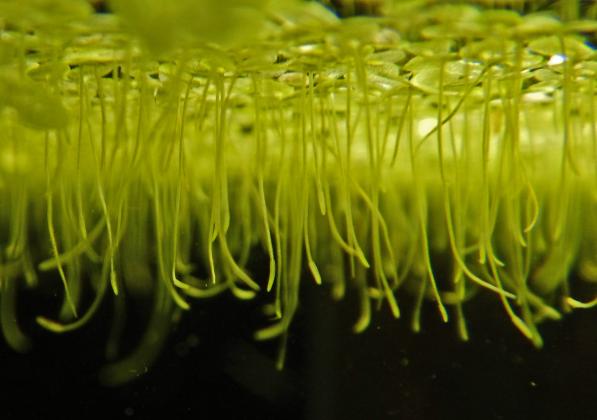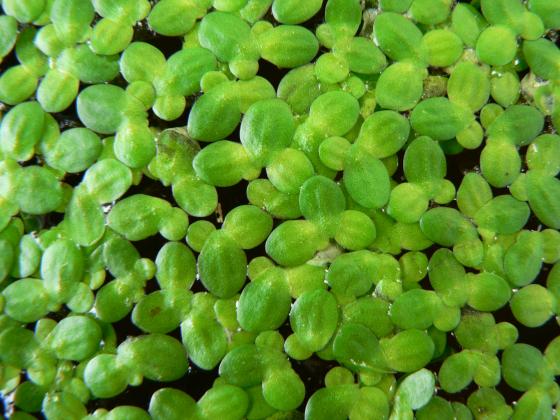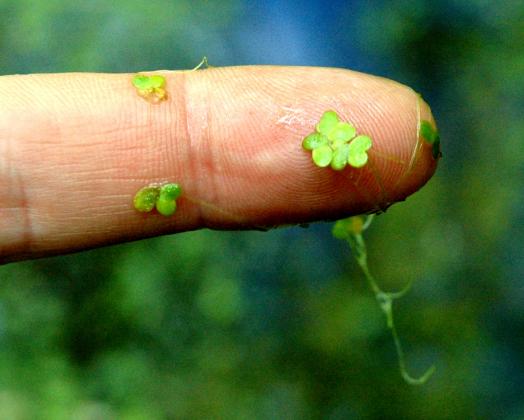Lemna minor – Soon in grocery stores?
Backyard Horticulture
Lemna minor and similar species of duckweed, are found floating in freshwater ponds and slow-moving streams in most of the world. It has from one to four green ¼ inch leaves, fronds, that look like floating green circles. Duckweed has no stems, branches nor visible flowers. Sticky roots hang down in the water and get carried to a new location when it sticks to an animal.
It primarily reproduces by budding. Leaves or stems have outgrowths that remain attached to the parent until fully grown. Then they fall off creating a genetically identical clone. Sometimes a seed sinks and lives off the nutrients at the bottom. When fully grown it floats to the top and is not a clone. Depending on the environment, duckweed can double in size from 16 hours to two days.
If it completely covers the surface, blocking the sun, oxygen depletion will harm life in the water. In a balanced ecosystem duckweed is kept in check by the many critters that eat it including fish, terrestrial and aquatic birds, especially ducks, frogs, snakes, insects, etc. It is also harvested as livestock and poultry feed and is eaten by humans.
The Food and Agriculture Organization of the United Nations, fao.org, leads international efforts to defeat hunger. One of their articles is “Duckweed: A tiny aquatic plant with enormous potential for agriculture and environment.” They found several duckweed species provided good nutrition for animals and humans. Also L. minor extracts had insecticidal action against some mosquitoes. Another use is as a replacement for chemical fertilizers which can contaminate groundwater.
The National Institutes of Health, ncbi.nlm.nih.gov, said duckweed protein content was from 20% to 35%, fat from 4% to 7% and starch from 4% to 10% per dry weight. The article is “Nutritional value of duckweeds (Lemnaceae) as human food.”
Before you make that duckweed smoothie remember that it will contain whatever is in the water including potentially harmful microbes. Also, one of the plant’s benefits is bioremediation. It cleans the environment by absorbing pollutants including heavy metals. It should only be harvested from a known clean source. While cooking will destroy microbes, it will not remove heavy metals. Duckweed plants can be purchased at your favorite online retailer. You can experiment using a kiddie pool.
The National Agricultural Library, pubag.nal.usda.gov, has a duckweed article, “Ecotoxicological evaluation of two anti-dandruff hair shampoos using Lemna minor.” Ecotoxicology is the study of the effects of toxic chemicals on organisms. Most homes and beauty shops use shampoo, so their ingredients are commonly found in municipal wastewater systems. There are few studies on the effect of shampoo on aquatic plants.
Traditional medicine systems use duckweed to treat inflammation of the mucous membranes of the nose such as the common cold or hay fever and other conditions.
Many other uses can be found by checking the patents at the U.S. Patent and Trademark Office, patft.uspto.gov, and the European Patent Office, worldwide.espacenet.com . I find the latter easier to search.
Deborah Richardson is a freelance reporter for The Examiner with a fondness for flora in its natural setting.




